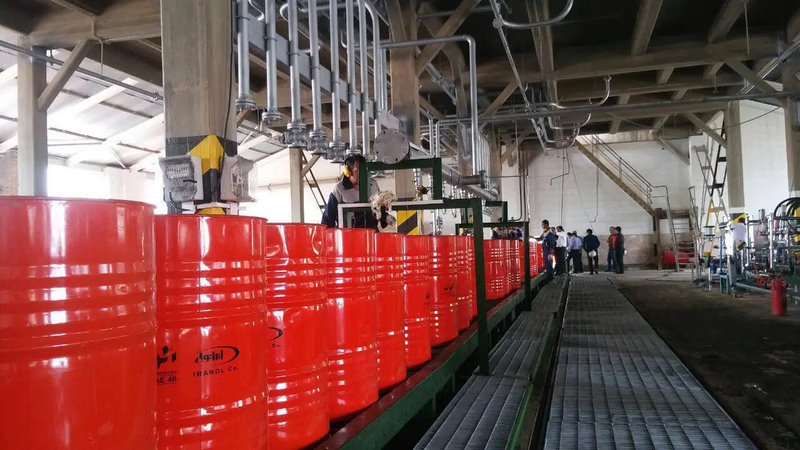
Motor oils from West Asia: Quality products for global markets.
The production of motor oils in West Asia can be affected by fluctuations in global crude oil prices. Since motor oils are derived from crude oil, changes in crude oil prices can impact the cost of producing base oils, which are the primary components of motor oils. Higher crude oil prices can increase production costs, leading to potential increases in motor oil prices. West Asian countries, such as Saudi Arabia, Iran, Iraq, and the United Arab Emirates, are major oil-producing nations. Their domestic oil production levels can influence the availability and supply of crude oil, which, in turn, can impact the production of motor oils. Higher domestic oil production can potentially lead to a greater availability of crude oil for refining into motor oils, which could help stabilize prices.
West Asian countries are prominent members of the Organization of the Petroleum Exporting Countries (OPEC). OPEC plays a crucial role in coordinating oil production and pricing strategies among its member countries. OPEC's decisions on production levels and export quotas can have a significant impact on global oil prices, which, in turn, can influence the production and pricing of motor oils in West Asia. The global demand for motor oils is an important factor in determining production levels and prices. West Asian countries export motor oils to various regions worldwide. Fluctuations in global demand can affect production decisions and pricing strategies. Economic growth, industrial activities, and transportation needs in different regions can influence the demand for motor oils, thereby affecting production levels and prices in West Asia.
West Asia is home to several major oil-producing countries that have robust motor oil industries. Countries like Saudi Arabia, Iran, and the United Arab Emirates have established motor oil production facilities and compete for market share both domestically and internationally. Competition among these countries can influence production decisions, pricing strategies, and product quality as they strive to capture market share. West Asia is known for its abundant crude oil reserves, which serve as the primary raw material for motor oil production. The availability of crude oil in the region can impact production levels and prices. Factors such as changes in production output, exploration activities, geopolitical tensions, and trade agreements can influence the availability and cost of raw materials, thereby affecting motor oil production and pricing.
Government policies and regulations can also influence the production and pricing of motor oils in West Asia. Governments may impose regulations related to production standards, quality control, environmental considerations, or pricing regulations that can impact the overall production and pricing dynamics in the region. Export of engine oil is one of the best engine oils in diesel and gasoline oils with international standards and approved by Germany, and the approval of oil exports is approved by various manufacturers and trading groups in the region. Engine oil is in great demand in Asian countries. The best motor oil producers in the Middle East make their products from high quality raw materials. Most of the manufacturing companies in the region offer the best products. They make engine oil for different cars, each with different models, and then sell it in packages.
Engine oil prices in the market are very diverse. In general, the price of engine oil depends on several factors. Engine oil type, viscosity, quality, volume and brand type affect the price of engine oil. All-synthetic oil is more expensive than semi-synthetic engine oil, which in turn is more expensive than conventional engine oil. Regarding viscosity, multi-grades are more expensive than single grades, and among the multi-grades themselves, the lower the number next to the letter W, the higher the price. For example, 5W-30 engine oil is more expensive than 10W-40.
West Asian countries have made substantial investments in technology and innovation to enhance their motor oil production capabilities. This includes the development of advanced refining processes, improved base oil formulations, and the introduction of additives to meet industry standards and specifications. Technological advancements can contribute to increased production efficiency, cost optimization, and the development of high-quality motor oils, which can influence prices and market competitiveness. West Asia has a diverse range of economies and market dynamics within the region. Some countries have growing domestic automotive industries and increasing motor oil consumption, while others rely more on export markets. These variations in regional market dynamics can impact production decisions and pricing strategies within West Asia.
The region's refining capacity plays a crucial role in the production of motor oils. West Asian countries have made significant investments in refining infrastructure, allowing them to process crude oil into various petroleum products, including motor oils. Higher refining capacity can contribute to increased production levels and potentially help meet domestic and international demand, which may have a stabilizing effect on prices. West Asian countries, with their abundant oil resources, often export motor oils to other regions. Export demand can impact production levels and prices. If there is high demand for West Asian motor oils in international markets, it may incentivize increased production to meet the export requirements, potentially affecting domestic prices.
-

Engine oil plays a crucial role in the lubrication and protection of automotive and industrial engines. It forms a protective film between moving parts, reducing friction and wear, which minimizes engine damage and extends lifespan. Engine oil also aids in cooling and cleaning by carrying away heat and contaminants. Various types of machinery, including generators, pumps, and heavy-duty equipment, rely on engine oil for optimal performance. Different applications necessitate specific grades of engine oil as per manufacturers" recommendations to ensure proper lubrication. Regular maintenance, including timely oil changes, is essential for maintaining performance and longevity. The primary functions of engine oil include lubrication to minimize friction, cooling internal components to prevent overheating, sealing between pistons and cylinders, and cleaning to reduce rust and sludge buildup. Marine engines require specialized oils that withstand harsh conditions like humidity and saltwater exposure.
Additionally, agricultural machinery, construction equipment, recreational vehicles (RVs), and motorcycles depend on tailored engine oils for efficient operation under demanding conditions. Understanding the specific needs of each application is vital for selecting the right engine oil. "
-

Motor oil production in West Asia is closely linked to global crude oil prices, as motor oils are derived from crude oil. Countries like Saudi Arabia, Iran, Iraq, and the UAE are significant players in this market. Their domestic oil production levels can influence the availability of crude oil for refining into motor oils, impacting production costs and prices. OPEC"s decisions on production levels also play a crucial role in shaping global oil prices, which directly affect motor oil pricing strategies in the region. The demand for motor oils globally is another critical factor; fluctuations can lead to changes in production levels and pricing strategies among West Asian producers. The region boasts advanced motor oil industries with established facilities that compete for both domestic and international market share. Factors such as government regulations, technological advancements, and varying regional market dynamics further influence production capabilities and pricing structures. Investments in refining infrastructure have enhanced the ability of these countries to process crude oil into high-quality motor oils efficiently.
Additionally, the diverse range of engine oils available—varying by type, viscosity, quality, and brand—contributes to a wide price spectrum in the market. As West Asia continues to innovate and adapt to changing market demands, its role as a key player in the global motor oil industry remains significant. "
-

Engine oil, essential for internal combustion engines, serves multiple functions including lubrication, cooling, and cleaning. It reduces friction and wear between moving parts, preventing damage and ensuring longevity. Engine oils are derived from mineral or synthetic bases, enhanced with additives for improved performance. Modern vehicles often feature oil life monitoring systems that optimize oil change intervals based on engine conditions. Synthetic oils outperform conventional oils in extreme temperatures and offer better fuel efficiency but come at a higher cost. Proper viscosity is crucial; it affects flow and protection under varying temperatures. Regular oil changes are necessary to maintain engine health. Additionally, used engine oil poses environmental risks if not recycled properly, necessitating adherence to disposal regulations. Understanding the specific requirements for different engines is vital for optimal performance.
-

Engine oils are categorized by viscosity grades like 5W-30 and 10W-40, indicating their flow resistance at varying temperatures. High-quality oils maintain viscosity, ensuring effective lubrication and protection under diverse conditions. They can be mineral or synthetic, with synthetic oils generally outperforming mineral ones in terms of lubrication, thermal stability, and oxidation resistance. Quality assessment involves performance testing for lubrication effectiveness, wear protection, and compatibility with emission systems. Selecting the right engine oil is crucial for maintaining engine health and efficiency; poor quality oil can lead to significant engine damage. Key considerations when purchasing include avoiding oils with black spots or unpleasant odors, checking for standard logos, ensuring freshness, and examining packaging quality. High-quality oils contain a balanced additive package that enhances performance by preventing sludge formation and reducing wear. The American Petroleum Institute (API) sets standards for engine oils; certification indicates compliance with industry requirements.
Original Equipment Manufacturers (OEMs) specify oil requirements to ensure compatibility with their engines. Adhering to international standards like ILSAC or ACEA further signifies a product"s quality. "
-

Engine oils are essential for the lubrication and protection of various engine types, including gasoline, diesel, and high-performance engines. Each type of engine oil is formulated to meet specific operational demands, such as temperature extremes and high RPMs. Conventional mineral oils provide basic lubrication but may fall short under extreme conditions. In contrast, synthetic oils offer superior performance with enhanced thermal stability and oxidation resistance, making them ideal for modern and high-performance engines. Motorcycle oils cater to the unique requirements of two-stroke and four-stroke engines, while racing oils are designed for extreme conditions encountered in motorsports. Diesel engine oils contain additives to manage soot and wear due to higher compression ratios. The market offers a range of options including semi-synthetic blends that combine the benefits of both synthetic and conventional oils. High mileage oils are tailored for older engines, helping to condition seals and reduce oil consumption.
Engine oil classifications include Group III (mineral), Group IV (PAO), and Group V (esters). Industry standards from organizations like API ensure that these oils meet performance requirements for viscosity, oxidation resistance, and wear protection. The diverse market allows consumers to select products based on their specific needs, preferences, and budget.





